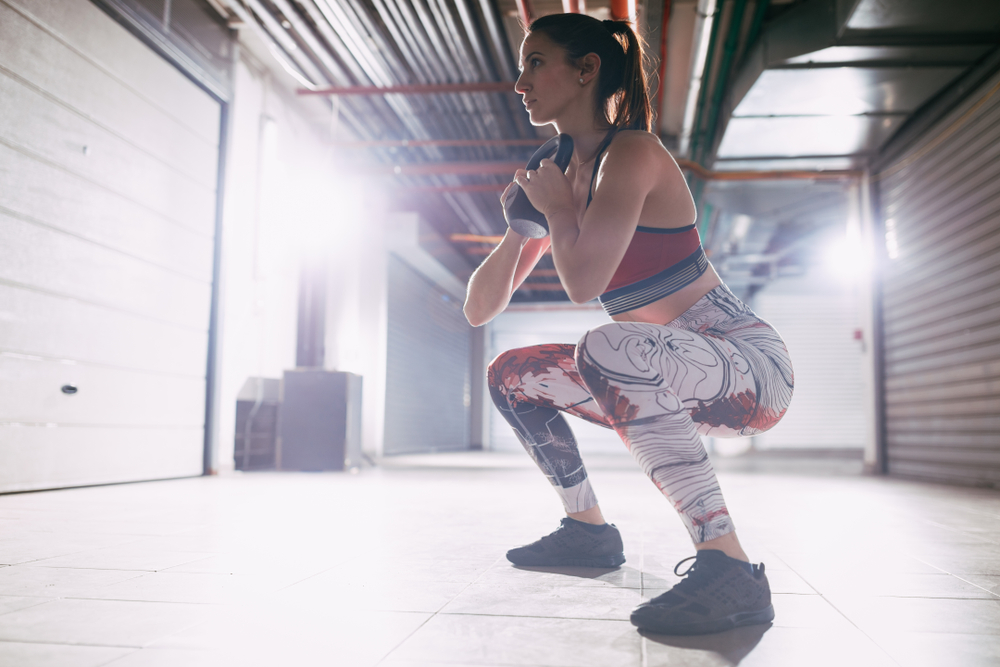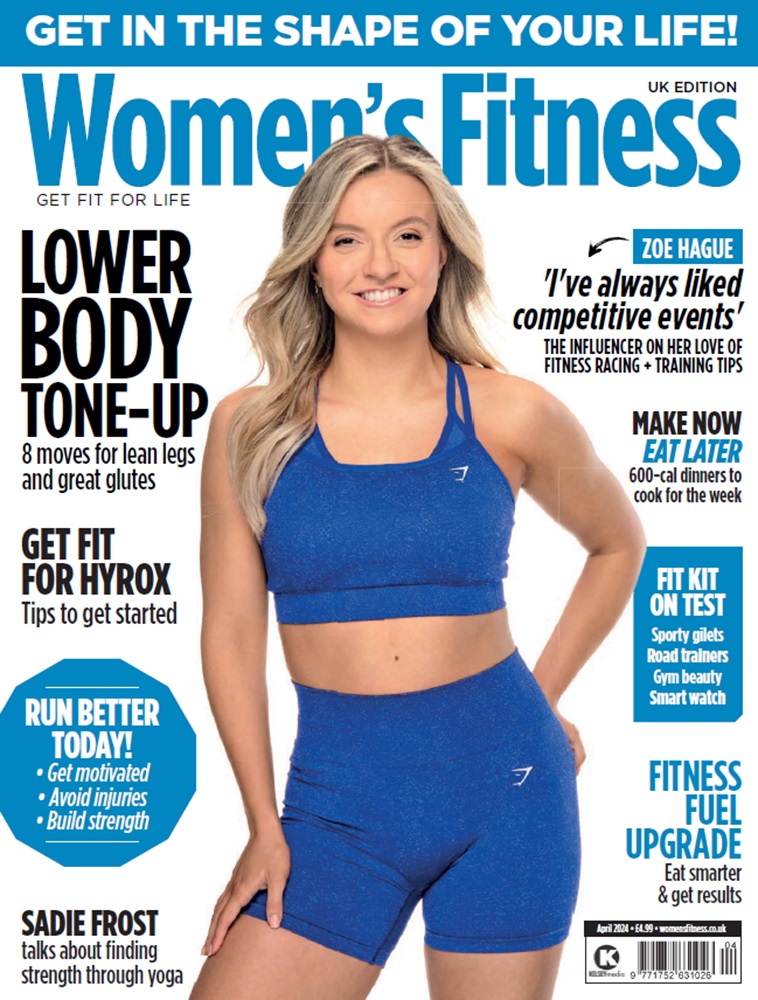Want to shed inches? Fast-track your results with strength training.
WORDS: Emma Lewis
Been banging out regular runs in the hope of losing a bit of jiggle around your middle? Well done on your commitment. But if you can’t lose fat as fast as you’d hoped, try strength training, too. Why? ‘While cardiovascular exercise helps the body burn more calories per session, lifting weights allows the body to burn more calories in the long term,’ concludes a report on health information site Medical News Today. This is down to getting a far greater EPOC (excess post-exercise oxygen consumption), or afterburn, effect with resistance training. Your metabolism stays elevated for several hours after strength workouts while your body works hard to repair and grow the muscle. Even better, muscle cells need lots of calories just to keep ticking over, so the more you have, the more energy you’ll burn while watching TV. So far so good.
Now let’s destroy the myth that still puts some women off resistance training: the one that says you’ll get huge muscles. We women can’t get as bulky as men, however much we pump that iron, simply because we have less muscle-building testosterone. We can, however, banish bingo wings in favour of beautifully toned, strong arms!
Still not convinced you want to pick up a kettlebell? According to an article in the journal Clinical Nutrition and Metabolic Care, physically inactive people can lose three-to-eight per cent of their muscle mass each decade after the age of 30, so it’s vital we look after those quads and triceps now to stave off problems in the future. ‘Strength training’s many benefits include improved posture and bone density,’ says Fiit trainer and author of Lift Yourself, Laura ‘Biceps’ Hoggins. And don’t forget mental health. ‘Many people see strength training as therapy. The feeling of empowerment and sense of achievement it provides is incredible,’ she adds. No wonder popularity for resistance workouts is sky-high among women right now, with celebs such as Gemma Atkinson, Ashley Graham and Eva Longoria all big fans. What’s not to like?
SUPERCHARGED STRENGTH
To make sure you’re getting the best results as quickly as possible, there are a few important factors to bear in mind. ‘A combination of cardio and strength training is the method that’s most likely to bring about the best weight- and fat-loss results,’ says Dr Kianoush Missaghi, PT and senior training experience manager at AI-based fitness and lifestyle coaching app Freeletics. ‘We recommend doing strength training around three times a week.’
And experts recommend thinking big by doing compound moves as much as possible to speed up fat-loss results. ‘A compound movement is where you use more than one joint and muscle group,’ says Rachael Penrose, certified PT and trainer at F45. ‘It allows you to get a full-body workout in a shorter amount of time, keeps your heart rate up and can mimic everyday, functional movements.’ Hoggins agrees that you shouldn’t dwell too long on biceps curls and the like. ‘Do big lifts, deadlifts, squats, lunges, push-ups, rows, plank variations and carries,’ she says.
FAT-MUNCHING METHODS
Daniel Harrod, runner up as Personal Trainer of the Year at the National Fitness Awards in 2019, has a good tip for how hard you should work. ‘It might be wise to use the “reps in reserve” method (how many reps you stop short of failure) and aiming for anywhere from one to three for each set would be advisable,’ he says. Through a little trial and error, you can then work out what weight you should use for each exercise when relevant. Progressive overload is a must, as it is in any form of exercise. ‘Increase the weight you’re using every few weeks, or add to the repetitions or the frequency that you train that muscle group,’ says Penrose. It’s also vital to keep your body guessing and boredom at bay. There are so many techniques out there, so check out everything from AMRAP (as many rounds as possible) and DUP (daily undulating periodisation) to rest/pause and partial reps to avoid the dreaded plateau. Lastly, don’t forget Hoggins’ wise words and give it your all: ‘If it’s not challenging you, it’s not changing you!’

1. METCON
Daniel Harrod recommends metabolic conditioning, or MetConWhat is it?
‘You use weighted exercises to challenge your whole body’s power and explosiveness, pushing you hard. There are several types you can try, including complexes (complete all reps as quickly as possible on one exercise before moving smoothly on to the next), metabolic chains (move smoothly from one exercise to the next, adding a rep to each move after each round) and the countdown (alternate quickly between two moves, eliminating a rep each time until you get down to one).’
Why does it work?
‘Performing these short bursts of high-intensity exercise with little or no rest in between will preserve muscle and promote the “afterburn effect”, as the increased tempo adds a cardio element to your workout.’
Try it yourself:
‘Select four exercises using one piece of equipment (such as dumbbell squats, dumbbell shoulder presses, dumbbell Romanian deadlifts and dumbbell bent-over rows). Complete 12 reps of each move, one after another, rest for 60 seconds between each full round and complete the process five times.’
TEMPO TRAINING
Laura Hoggins suggests tempo training and isometrics
What is it?
‘Tempo training is all about increasing the time your muscles are under tension for different phases of exercises, and isometrics are where you produce muscular contraction without moving that part of the body (think of a plank, for instance).’
Why does it work?
‘Since you’re keeping your muscles under tension for longer, you’re creating greater stress on them, which leads to strength gains. It also works well if you only have limited weights at home, as you can create the tension without using heavy weights.’
Try it yourself:
‘Complete four sets of 10-12 reps of goblet squats (holding a dumbbell or kettlebell) where you take three seconds to slowly lower to the bottom of your range, then drive up fast! Mix up the tempo on the way down and add an isometric hold, too. For example, squat 41X0 (take four seconds going down, hold for one second at the bottom of the move, then drive up as fast as possible). Try it with press-ups too, for upper-body strength: 22X0 (two seconds down, two-second hold and drive up fast).’
SUPERSETS
Rachael Penrose swears by the superset
What are they?
‘You do two exercises back to back with little to no rest in between. There are several types but, for example, you can work two antagonistic (opposing) muscle groups such as the biceps and triceps. This method works well for push and pull-type moves, and the muscle group just worked has a rest while you work the other one. I also like to use the concept in a more general way to do an upper-body then a lower-body move.’
Why do they work?
‘If you use the same muscle group in the same way back to back, such as with three sets of biceps curls, your muscles fatigue and you need a rest between sets. With most supersets, you rest one set of muscles while working another, so the cardio system has to keep going. This is great for burning calories and therefore for fat loss. When you’re switching moves between the upper and lower body, you create peripheral heart action (PHA), which means your heart has to work even harder to move the blood from one half of the body to the other.’
Try them yourself:
‘Do eight chest presses or push-ups (upper body), followed straight away by eight squats (lower body). Then rest for 90 seconds before repeating the superset twice.’
PYRAMID SETS
Dr Missaghi recommends you try pyramid sets
What are they?
‘Pyramid sets (specific to strength training) are when you increase the weight and decrease the reps, then decrease the weight and increase the reps for each set until you’re back where you started. By adjusting the weight and sets, you should reach the maximum that you can tolerate in each set.’
Why do they work?
‘Pyramid sets are a great type of training for creating metabolic stress in muscle tissue, which causes the muscles to grow bigger and use more energy, helping you to reduce fat.’
Try them yourself:
‘Here’s an example set for weighted squats using a kettlebell: Set 1: 5kg x 12 reps, Set 2: 8kg x 10 reps, Set 3: 10kg x 8 reps, Set 4: 12kg x 5 reps, Set 5: 10kg x 8 reps, Set 6: 8kg x 10 reps, Set 7: 5kg x 12 reps. If you don’t have a kettlebell at home, try choosing everyday items such as a water bottle, varying the amount of water in the bottle to increase and decrease the weight.’
Want more workout inspiration? Follow our Get fit in 30 days! plan








